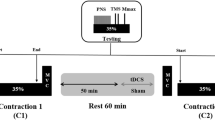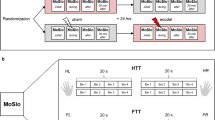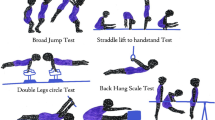Abstract
Purpose
This study aimed to explore the acute effect of transcranial direct current stimulation (tDCS) on the force–velocity relationship, strength training volume, movement velocity, and ratings of perceived exertion.
Methods
Fourteen healthy men (age 22.8 ± 3.0 years) were randomly stimulated over the dorsolateral prefrontal cortex with either ANODAL, CATHODAL or SHAM tDCS for 15 min at 2 mA. The one-repetition maximum (1RM) and force–velocity relationship parameters were evaluated during the bench press exercise before and after receiving the tDCS. Subsequently, participants completed a resistance training session consisting of sets of five repetitions with 1 min of inter-set rest against the 75%1RM until failure.
Results
No significant changes were observed in the 1RM or in the force–velocity relationship parameters (p ≥ 0.377). The number of repetitions was higher for the ANODAL compared to the CATHODAL (p = 0.025; ES = 0.37) and SHAM (p = 0.009; ES = 0.47) conditions. The reductions of movement velocity across sets were lower for the ANODAL than for the CATHODAL and SHAM condition (p = 0.014). RPE values were lower for the ANODAL compared to the CATHODAL (p = 0.119; ES = 0.33) and SHAM (p = 0.150; ES = 0.44) conditions. No significant differences between the CATHODAL and SHAM conditions were observed for any variable.
Conclusion
The application of ANODAL tDCS before a resistance training session increased training volume, enabled the maintenance of higher movement velocities, and reduced RPE values. These results suggest that tDCS could be an effective method to enhance resistance-training performance.




Similar content being viewed by others
Abbreviations
- a.u.:
-
Arbitrary units
- BP:
-
Bench press
- DLPC:
-
Dorsolateral prefrontal cortex
- F–V :
-
Force–velocity relationship
- F 0 :
-
Regression parameter (F-intercept) depicting maximum force
- L–V :
-
Load velocity relationship
- M1:
-
Primary motor cortex
- PFC:
-
Prefrontal cortex
- P max :
-
Regression parameter [(F0·V0)/4] depicting maximum power
- RPE:
-
Rating of perceived exertion
- tDCS:
-
Transcranial direct current stimulation
- V 0 :
-
Regression parameter (V-intercept) depicting maximum velocity
- 1RM:
-
One repetition maximum
References
Alix-Fages C, Romero-Arenas S, Castro-Alonso M, Colomer-Poveda D, Río-Rodriguez D, Jerez-Martínez A, Fernandez-Del-Olmo M, Márquez G (2019) Short-term effects of anodal transcranial direct current stimulation on endurance and maximal force production. A systematic review and meta-analysis. J Clin Med 8(4):536. https://doi.org/10.3390/jcm8040536
Angius L, Hopker JG, Marcora SM, Mauger AR (2015) The effect of transcranial direct current stimulation of the motor cortex on exercise-induced pain. Eur J Appl Physiol 115(11):2311–2319. https://doi.org/10.1007/s00421-015-3212-y
Angius L, Hopker J, Mauger AR (2017) The ergogenic effects of transcranial direct current stimulation on exercise performance. Front Physiol. https://doi.org/10.3389/fphys.2017.00090
Angius L, Mauger ARR, Hopker J, Pascual-Leone A, Santarnecchi E, Marcora SMM (2018) Bilateral extracephalic transcranial direct current stimulation improves endurance performance in healthy individuals. Brain Stimul 11(1):108–117. https://doi.org/10.1016/j.brs.2017.09.017
Angius L, Pageaux B, Hopker J, Marcora SM, Mauger AR (2016) Transcranial direct current stimulation improves isometric time to exhaustion of the knee extensors. Neuroscience 339:363–375. https://doi.org/10.1016/j.neuroscience.2016.10.028
Barbalho M, Coswig VS, Steele J, Fisher JP, Giessing J, Gentil P (2019) Evidence of a ceiling effect for training volume in muscle hypertrophy and strength in trained men—less is more? Int J Sports Physiol Perform. https://doi.org/10.1123/ijspp.2018-0914
Cohen J (1988) Statistical power analysis for the behavioral sciences. Stat Power Anal Behav Sci. https://doi.org/10.1234/12345678
DaSilva AF, Volz MS, Bikson M, Fregni F (2011) Electrode positioning and montage in transcranial direct current stimulation. J Vis Exp. https://doi.org/10.3791/2744
de Freitas MC, Gerosa-Neto J, Zanchi NE, Lira FS, Rossi FE (2017) Role of metabolic stress for enhancing muscle adaptations: practical applications. World J Methodol. https://doi.org/10.5662/wjm.v7.i2.46
Flood A, Waddington G, Keegan RJ, Thompson KG, Cathcart S (2017) The effects of elevated pain inhibition on endurance exercise performance. PeerJ 5:e3028. https://doi.org/10.7717/peerj.3028
Frazer A, Williams J, Spittles M, Rantalainen T, Kidgell D (2016) Anodal transcranial direct current stimulation of the motor cortex increases cortical voluntary activation and neural plasticity. Muscle Nerve 54(5):903–913. https://doi.org/10.1002/mus.25143
Gandiga PC, Hummel FC, Cohen LG (2006) Transcranial DC stimulation (tDCS): a tool for double-blind sham-controlled clinical studies in brain stimulation. Clin Neurophysiol. https://doi.org/10.1016/j.clinph.2005.12.003
García-Ramos A, Haff GG, Pestaña-Melero FL, Pérez-Castilla A, Rojas FJ, Balsalobre-Fernández C, Jaric S (2018a) Feasibility of the 2-point method for determining the 1-repetition maximum in the bench press exercise. Int J Sports Physiol Perform 13(4):474–481. https://doi.org/10.1123/ijspp.2017-0374
Garcia-Ramos A, Jaric S (2018) Optimization of the force-velocity relationship obtained from the bench press throw exercise: an a-posteriori multicentre reliability study. Int J Sports Physiol Perform. https://doi.org/10.1123/ijspp.2018-0457
García-Ramos A, Torrejón A, Feriche B, Morales-Artacho AJ, Pérez-Castilla A, Padial P, Haff GG (2018b) Prediction of the maximum number of repetitions and repetitions in reserve from barbell velocity. Int J Sports Physiol Perform 13(3):353–359. https://doi.org/10.1123/ijspp.2017-0302
González-Badillo JJ, Rodríguez-Rosell D, Sánchez-Medina L, Gorostiaga EM, Pareja-Blanco F (2014) Maximal intended velocity training induces greater gains in bench press performance than deliberately slower half-velocity training. Eur J Sport Sci 18:772–781. https://doi.org/10.1080/17461391.2014.905987
González-Badillo JJ, Sánchez-Medina L (2010) Movement velocity as a measure of loading intensity in resistance training. Int J Sports Med. https://doi.org/10.1055/s-0030-1248333
Hackett DA, Amirthalingam T, Mitchell L, Mavros Y, Wilson GC, Halaki M (2018) Effects of a 12-week modified german volume training program on muscle strength and hypertrophy—a pilot study. Sports. https://doi.org/10.3390/sports6010007
Hazime FA, da Cunha RA, Soliaman RR, Romancini ACB, de Pochini AC, Ejnisman B, Baptista AF (2017) Anodal transcranial direct current stimulation (tDCS) increases isometric strength of shoulder rotators muscles in handball players. Int J Sports Phys Ther 12(3):402–407
Heaselgrave SR, Blacker J, Smeuninx B, McKendry J, Breen L (2018) Dose-response of weekly resistance training volume and frequency on muscular adaptations in trained males. Int J Sports Physiol Perform. https://doi.org/10.1123/ijspp.2018-0427
Herwig U, Satrapi P, Schönfeldt-Lecuona C (2003) Using the international 10–20 EEG system for positioning of transcranial magnetic stimulation. Brain Topogr. https://doi.org/10.1023/B:BRAT.0000006333.93597.9d
Hilty L, Langer N, Pascual-Marqui R, Boutellier U, Lutz K (2011) Fatigue-induced increase in intracortical communication between mid/anterior insular and motor cortex during cycling exercise. Eur J Neurosci. https://doi.org/10.1111/j.1460-9568.2011.07909.x
Kan B, Dundas JE, Nosaka K (2013) Effect of transcranial direct current stimulation on elbow flexor maximal voluntary isometric strength and endurance. Appl Physiol Nutr Metab 38(7):734–739. https://doi.org/10.1139/apnm-2012-0412
Krieger JW (2009) Single versus multiple sets of resistance exercise: a meta-regression. J Strength Cond Res. https://doi.org/10.1519/JSC.0b013e3181b370be
Krieger JW (2010) Single vs multiple sets of resistance exercise for muscle hypertrophy: a meta-analysis. J Strength Cond Res. https://doi.org/10.1519/JSC.0b013e3181d4d436
Laakso I, Mikkonen M, Koyama S, Hirata A, Tanaka S (2019) Can electric fields explain inter-individual variability in transcranial direct current stimulation of the motor cortex? Sci Rep 9(1):626. https://doi.org/10.1038/s41598-018-37226-x
Laakso I, Tanaka S, Koyama S, De Santis V, Hirata A (2015) Inter-subject variability in electric fields of motor cortical tDCS. Brain Stimul 8(5):906–913. https://doi.org/10.1016/j.brs.2015.05.002
Lattari E, Andrade ML, Filho AS, Moura AM, Neto GM, Silva JG, Machado S (2016) Can transcranial direct current stimulation improve the resistance strength and decrease the rating perceived scale in recreational weight-training experience? J Strength Cond Res 30(12):3381–3387. https://doi.org/10.1519/JSC.0000000000001457
Lattari E, Campos C, Lamego MK, Passos de Souza SL, Neto GM, Rocha NB, Machado S (2017) Can transcranial direct current stimulation improve muscle power in individuals with advanced resistance training experience? J Strength Cond Res. https://doi.org/10.1519/JSC.0000000000001956
Lattari E, de Oliveira BS, Oliveira BRR, de Mello Pedreiro RC, Machado S, Neto GAM (2018a) Effects of transcranial direct current stimulation on time limit and ratings of perceived exertion in physically active women. Neurosci Lett 662:12–16. https://doi.org/10.1016/j.neulet.2017.10.007
Lattari E, Oliveira BRR, Monteiro Júnior RS, Marques Neto SR, Oliveira AJ, Maranhão Neto GA, Budde H (2018b) Acute effects of single dose transcranial direct current stimulation on muscle strength: a systematic review and meta-analysis. PLoS ONE 13(12):e0209513. https://doi.org/10.1371/journal.pone.0209513
Lattari E, Rosa Filho BJ, Fonseca Junior SJ, Murillo-Rodriguez E, Rocha N, Machado S, Maranhão Neto GA (2018c) Effects on volume load and ratings of perceived exertion in individuals advanced weight-training after transcranial direct current stimulation. J Strength Cond Res. https://doi.org/10.1519/JSC.0000000000002434
Li LM, Uehara K, Hanakawa T (2015) The contribution of interindividual factors to variability of response in transcranial direct current stimulation studies. Front Cell Neurosci. https://doi.org/10.3389/fncel.2015.00181
Liu JZ, Shan ZY, Zhang LD, Sahgal V, Brown RW, Yue GH (2003) Human brain activation during sustained and intermittent submaximal fatigue muscle contractions: an fMRI study. J Neurophysiol 90(1):300–312. https://doi.org/10.1038/s41598-017-03078-0
López-Alonso V, Cheeran B, Río-Rodríguez D, Fernández-Del-Olmo M (2014) Inter-individual variability in response to non-invasive brain stimulation paradigms. Brain Stimul 7(3):372–380. https://doi.org/10.1016/j.brs.2014.02.004
Menotti F, Berchicci M, Di Russo F, Damiani A, Vitelli S, Macaluso A (2014) The role of the prefrontal cortex in the development of muscle fatigue in Charcot-Marie-Tooth 1A patients. Neuromuscul Disord. https://doi.org/10.1016/j.nmd.2014.03.010
Muthalib M, Kan B, Nosaka K, Perrey S (2013) Effects of transcranial direct current stimulation of the motor cortex on prefrontal cortex activation during a neuromuscular fatigue task: an fNIRS study. Adv Exp Med Biol. https://doi.org/10.1007/978-1-4614-7411-1_11
Nitsche MA, Fricke K, Henschke U, Schlitterlau A, Liebetanz D, Lang N, Paulus W (2003) Pharmacological modulation of cortical excitability shifts induced by transcranial direct current stimulation in humans. J Physiol 553(1):293–301. https://doi.org/10.1113/jphysiol.2003.049916
Nitsche MA, Paulus W (2000) Excitability changes induced in the human motor cortex by weak transcranial direct current stimulation. J Physiol 527(Pt 3):633–639. https://doi.org/10.1111/j.1469-7793.2000.t01-1-00633.x
Nitsche MA, Paulus W (2001) Sustained excitability elevations induced by transcranial DC motor cortex stimulation in humans. Neurology 57(10):1899–1901. https://doi.org/10.1212/WNL.57.10.1899
Okano AH, Fontes EB, Montenegro RA, Detarso Veras-Farinatti P, Cyrino ES, Li LM, Noakes TD (2015) Brain stimulation modulates the autonomic nervous system, rating of perceived exertion and performance during maximal exercise. Br J Sports Med 49(18):1213–1218. https://doi.org/10.1136/bjsports-2012-091658
Pareja-Blanco F, Rodríguez-Rosell D, Sánchez-Medina L, Sanchis-Moysi J, Dorado C, Mora-Custodio R, González-Badillo JJ (2017) Effects of velocity loss during resistance training on athletic performance, strength gains and muscle adaptations. Scand J Med Sci Sports 27(7):724–735. https://doi.org/10.1111/sms.12678
Perrey S, Radel R, Brisswalter J (2016) Exercise termination is a cognitively controlled decision. J Appl Physiol. https://doi.org/10.1152/japplphysiol.00967.2015
Poreisz C, Boros K, Antal A, Paulus W (2007) Safety aspects of transcranial direct current stimulation concerning healthy subjects and patients. Brain Res Bull 72(4–6):208–214. https://doi.org/10.1016/j.brainresbull.2007.01.004
Radaelli R, Fleck SJ, Leite T, Leite RD, Pinto RS, Fernandes L, Simão R (2015) Dose-response of 1, 3, and 5 sets of resistance exercise on strength, local muscular endurance, and hypertrophy. J Strength Cond Res. https://doi.org/10.1519/JSC.0000000000000758
Ralston GW, Kilgore L, Wyatt FB, Baker JS (2017) The effect of weekly set volume on strength gain: a meta-analysis. Sports Med. https://doi.org/10.1007/s40279-017-0762-7
Rivière JR, Rossi J, Jimenez-Reyes P et al (2017) Where does the one-repetition maximum exist on the force-velocity relationship in squat? Int J Sports Med. https://doi.org/10.1055/s-0043-116670
Robertson RJ, Goss FL, Rutkowski J, Lenz B, Dixon C, Timmer J, Andreacci J (2003) Concurrent validation of the OMNI perceived exertion scale for resistance exercise. Med Sci Sports Exerc 35(2):333–341. https://doi.org/10.1249/01.MSS.0000048831.15016.2A
Robertson CV, Marino FE (2016) A role for the prefrontal cortex in exercise tolerance and termination. J Appl Physiol 120(4):464–466. https://doi.org/10.1152/japplphysiol.00363.2015
Rosati S, Castagneri C, Agostini V, Knaflitz M, Balestra G (2017) Muscle contractions in cyclic movements: optimization of CIMAP algorithm. Proc Annu Int Conf IEEE Eng Med Biol Soc EMBS. https://doi.org/10.1109/EMBC.2017.8036762
Savulescu J, Foddy B, Clayton M (2004) Why we should allow performance enhancing drugs in sport. Br J Sports Med 38(6):666–670. https://doi.org/10.1136/bjsm.2003.005249
Schoenfeld BBJ, Ogborn D, Krieger JJW (2017) Dose-response relationship between weekly resistance training volume and increases in muscle mass: a systematic review and meta-analysis. J Sports Sci 35(11):1073–1082. https://doi.org/10.1080/02640414.2016.1210197
Schoenfeld BJ, Contreras B, Krieger J, Grgic J, Delcastillo K, Belliard R, Alto A (2019) Resistance training volume enhances muscle hypertrophy. Med Sci Sports Exerc. https://doi.org/10.1249/mss.0000000000001764
Schoenfeld BJ, Wilson JM, Lowery RP, Krieger JW (2016) Muscular adaptations in low- versus high-load resistance training: a meta-analysis. Eur J Sport Sci. https://doi.org/10.1080/17461391.2014.989922
Stagg CJ, Nitsche MA (2011) Physiological basis of transcranial direct current stimulation. Neuroscientist. https://doi.org/10.1177/1073858410386614
Taylor JL, Amann M, Duchateau J, Meeusen R, Rice CL (2016) Neural contributions to muscle fatigue: From the brain to the muscle and back again. Med Sci Sports Exerc 48(11):2294–2306. https://doi.org/10.1249/MSS.0000000000000923
Teka WW, Hamade KC, Barnett WH, Kim T, Markin SN, Rybak IA, Molkov YI (2017) From the motor cortex to the movement and back again. PLoS ONE. https://doi.org/10.1371/journal.pone.0179288
Terzis G, Spengos K, Mascher H, Georgiadis G, Manta P, Blomstrand E (2010) The degree of p70S6k and S6 phosphorylation in human skeletal muscle in response to resistance exercise depends on the training volume. Eur J Appl Physiol. https://doi.org/10.1007/s00421-010-1527-2
Vargas VZ, Baptista AF, Pereira GOC, Pochini AC, Ejnisman B, Santos MB, Hazime FA (2018) Modulation of isometric quadriceps strength in soccer players with transcranial direct current stimulation: a crossover study. J Strength Cond Res 32(5):1336–1341. https://doi.org/10.1519/JSC.0000000000001985
Washabaugh EP, Santos L, Claflin ES, Krishnan C (2016) Low-level intermittent quadriceps activity during transcranial direct current stimulation facilitates knee extensor force-generating capacity. Neuroscience 329:93–97. https://doi.org/10.1016/j.neuroscience.2016.04.037
Williams PS, Hoffman RL, Clark BC (2013) Preliminary evidence that anodal transcranial direct current stimulation enhances time to task failure of a sustained submaximal contraction. PLoS ONE 8(12):e81418. https://doi.org/10.1371/journal.pone.0081418
Acknowledgements
We would like to thank all the subjects who selflessly participated in the study.
Author information
Authors and Affiliations
Contributions
CA-F, AG-R, DC-P and GM conceived the study design. CA-F, GC-N, DC-P and GM conducted the experiments. AG-R and GM conducted the statistical analyses. AG-R, DC-P, SR-A, MF-O and GM interpreted the results. CA-F, AG-R, DC-P, SR-A, MF-O and GM: wrote the manuscript. All authors read and approved the final manuscript version.
Corresponding author
Ethics declarations
Conflict of interest
The authors declare that they have no conflict of interest.
Additional information
Communicated by Westerterp/Westerblad.
Publisher's Note
Springer Nature remains neutral with regard to jurisdictional claims in published maps and institutional affiliations.
Rights and permissions
About this article
Cite this article
Alix-Fages, C., García-Ramos, A., Calderón-Nadal, G. et al. Anodal transcranial direct current stimulation enhances strength training volume but not the force–velocity profile. Eur J Appl Physiol 120, 1881–1891 (2020). https://doi.org/10.1007/s00421-020-04417-2
Received:
Accepted:
Published:
Issue Date:
DOI: https://doi.org/10.1007/s00421-020-04417-2




